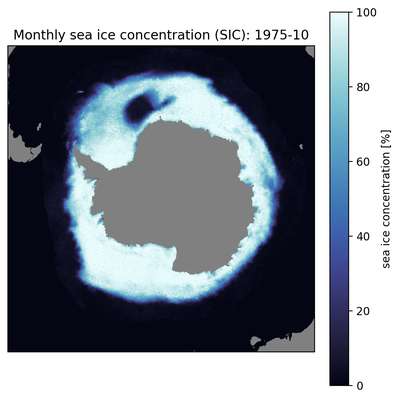An updated version of the ESMR Sea Ice Concentration Dataset (V1.1) has been released, providing significant improvements in data quality and quantity of historical sea ice conditions from 1972-1977 in the Artic and Antarctic. Changes in global sea ice are a highly relevant indicator and driver of climate change. An enhanced algorithm in this latest version delivers more accurate, detailed and comprehensive estimates of sea ice concentration in the polar regions, while continuing to ensure that the dataset meets modern standards for climate data records. Two years ago, a team of scientists from the Technical University of Denmark (DTU), working as part of the ESA Climate Change initiative (CCI) Sea Ice project, introduced the first version of this groundbreaking satellite data product, offering unprecedented insights into global sea ice development during the early 1970s. With substantial refinements over the previous version, the latest update provides researchers with even better analytical capabilities for historical sea ice trends and more understanding of how sea ice interacts with the global climate system.
Nimbus-5 ESMR sea ice concentration dataset sheds new light on previously unseen historic global sea ice formation

Due to its crucial role in regulating the Earth's climate, sea ice is one of 55 Essential Climate Variables (ECVs) recognised by the scientific and policy-making communities for monitoring and characterising the Earth's climate. Prior to the release of the Nimbus-5 ESMR Sea Ice Concentration Dataset, the existing sea ice climate records - although some of the longest available - only go back to 1979. One of the main objectives of ESA's CCI is to generate robust long-term climate satellite records by harnessing the current and historical Earth Observation archive. To this end, Rasmus Tonboe and his team at DTU have used data from the Electrical Scanning Microwave Radiometer (ESMR) onboard Nimbus-5 to reveal sea ice data for 1972-1977, filling a critical gap in the climate record.
To ensure consistency, the team used the same processing method for the 1972-1977 data as for the 1979-present record, allowing researchers to confidently analyse long-term trends in sea ice conditions. This pioneering work highlights the potential of microwave radiometry for mapping sea ice and sets a new benchmark for reconstructing historical climate data.
“Our satellite data product provides valuable context for recent changes, such as the sharp decline in Antarctic sea ice since 2016, and the variability of features such as the Weddell Sea polynya in the 1970s. Long-term datasets are essential for understanding sea ice change processes. By integrating historical and contemporary Earth observation archives, we have created a vital resource that improves the validation of climate models, strengthens the reliability of predictions and deepens our understanding of the rapidly changing Arctic and Antarctic environment” – Rasmus Tonboe, Associate Professor at DTU Space and part of the ESA CCI Sea Ice project.
Dataset accessibility:
The Nimbus-5 ESMR Sea Ice Concentration Dataset (version 1.1) is now available for download from the ESA Climate Change Initiative's Open Data Portal. This 25 km gridded dataset is the latest addition to ESA's sea ice data products, providing researchers with a more complete and reliable record of historical sea ice conditions.

